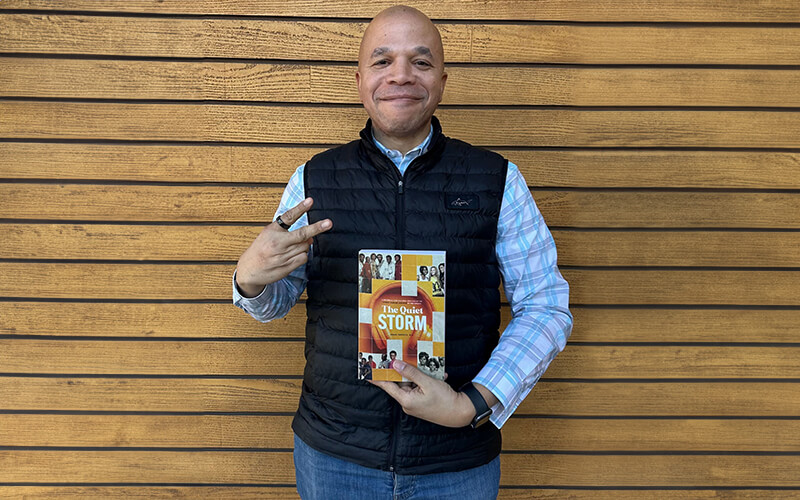
From The Supremes to Earth, Wind and Fire, R&B has left an indelible mark on American popular culture.
Amani Roberts, lecturer in management at the CSUF College of Business and Economics, is the author of “The Quiet Storm: A Historical and Cultural Analysis of the Power, Passion, and Pain of R&B Groups.”
The book, which will debut on Feb. 18 during Black History Month, is designed to be both a textbook and a popular history, applicable to African American studies, music history and music practitioners around the world. Decades in the making, Roberts’ book aims to be a definitive review of the genre.
Roberts’ interest in R&B began in his youth in Maryland, where he grew up in junior high and high school jazz bands. After working in corporate America, Roberts began working in the industry as a DJ and grew his music entertainment business, The Amani Experience.
In grad school at Berklee College of Music, Roberts’ thesis was on the decline of Black R&B groups. Expanded and supplemented with additional observations, historical analysis and the input of business Titans, Roberts’ graduate thesis formed the basis of his forthcoming book.
“It’s a book now, but it will turn into a documentary in the future,” said Roberts. “We’re looking at a seven- to eight-episode series. We’re working to find a partner and gather footage and video. PBS, Netflix, HBO or Amazon Prime are some of the distributors being examined.”
Roberts’ book starts in the 1950s and follows the evolution and rise and fall of the genre throughout the cultural, social and economic changes of the last half of the 20th century.
“I start with doo-wop groups that would sing around the street corner. Then, there was the influx of rock groups that would transition to R&B groups. The Isley Brothers were a great example. Their first hit ‘Shout’ was a rock sound, but switched to R&B.”
Blues, which originated in the early 1900s, provided the genesis for R&B. But as Roberts chronicles in his book, the genre would take in many styles and formats over the decades. “The Supremes and their run of hits in the 1960s — 11 of their 13 singles topped the charts, which was unprecedented — was a major moment,” said Roberts. “And then during the Civil Rights Movement, Parliament Funkadelic and The Temptations were leading groups during the Motown era. When record producer Berry Gordy first signed The Supremes, he initially only allowed them to clap hands on songs. Then he allowed them to sing backup. Only later could they sing lead vocals. Their resilience was remarkable.”
The 1970s brought the world the shows of Earth, Wind and Fire and Kool & the Gang, which lifted the genre to new heights.
“The 1980s was a bit of a lull, and then from there, it really exploded in the ’90s, which was the golden era for R&B groups. People love the ’90s R&B, but you could give some credence to the 1970s. The ’80s was a bridge,” said Roberts. “In the 2000s, you had Destiny’s Child and their all-star member Beyonce, but when they started doing their solo projects in the mid-2000s, R&B started to fall off the map. Singular artists, the rise of modern platforms such as YouTube and the Great Recession combined to create an imperfect storm for R&B.”
Still, Roberts takes heart that R&B isn’t going to disappear anytime soon. “R&B will always be here. It is the foundation of what we love in pop music and EDM. I question, however, whether groups will come back. Bruno Mars and Anderson Paak, which make up the group Silk Sonic, will come out with an album that does well, but then they go back to individual projects. It’s a different landscape now in all genres where groups struggle,” said Roberts. “Still, K-pop groups are following the playbook of Destiny’s Child and other R&B groups, which lead me to believe that music groups can succeed if properly funded and marketed. But it’s harder now and requires a lot more effort.”
Currently, Roberts is a fan of some promising individual R&B artists, such as SZA, H.E.R., Leela James, Kevin Ross and Summer Walker. And people are still following older bands such as Earth, Wind and Fire; The Gap Band; and Boyz II Men. “Most people have heard of some of them, and today’s young people can listen and explore the genre that way,” said Roberts.
Read the complete article on CSUF Business News.